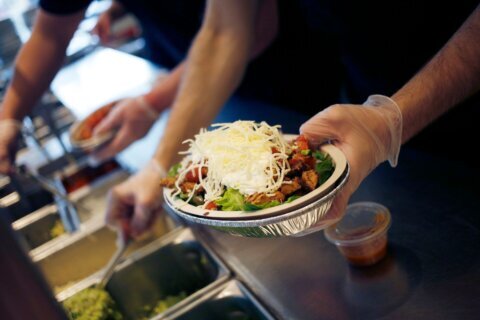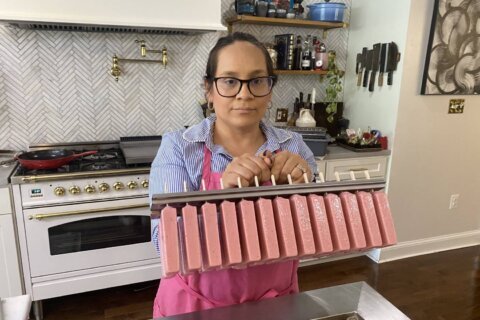WASHINGTON — Farmers market maven Amelia Saltsman wants to take your Hanukkah spread to the next level.
For years, the cookbook author and fresh foods guru has imparted the importance of seasonal eating by helping home cooks — and experts — turn farmers market finds into savory dishes and tasty treats.
Her new mission? To change the way Americans think about Jewish food.
In her latest project, “The Seasonal Jewish Kitchen,” Saltsman combines her farm-to-table ethos with her family’s history and heritage.
“We always go to our touchstones, wherever we came from; it’s just part of how we think about food,” says Saltsman, a California native and daughter of a Romanian mother and Iraqi father.
Her book skips over the heavy and often deli-associated Jewish fare, and instead focuses on bright and bold flavors that draw on influences from North Africa, the Middle East and Eastern Europe.
“It kind of circles us back around from our 21st century interests in seasonality and sustainability to the ancient roots of those traditions, which are really the foundation of Jewish culture,” Saltsman says.
Just in time for Hanukkah, she’s sharing some of her favorite late fall and early winter recipes.
—
Saltsman has a no-frills approach to cooking, and often recycles her favorite techniques on different ingredients. Take, for example, her approach to roasting vegetables — no matter the variety.
“My way is to just cut up the best ingredients you find — hopefully from local farmers — put them in a roasting pan, douse them with fresh orange juice and citrus zest and shove it all in a hot oven for an hour until it’s browned and caramelized and rich with flavor,” Saltsman says.
“I think life should just be that simple.”
This time of year, parsnips, potatoes, sweet potatoes and turnips are in season in the D.C. area, as are winter squashes, which make a nice addition to the roasting pan.
Saltsman also has a great roasting recipe for Brussels sprouts, where she uses pomegranate molasses, toasted walnuts and shanklish (labneh seasoned with za’atar and Aleppo pepper). It’s a simple side dish that adds tangy and cool flavors to your holiday menu.
“It’s the perfect dish to get you through the fall and winter, and it really represents … more Middle Eastern flavors, which is a different profile than many Americans are used to thinking about Jewish food.”
It’s not Hanukkah without latkes. But around the holidays, Saltsman likes to shake up the traditional potato pancakes with her bite-sized sweet potato and butternut squash latkes, topped with shanklish and harissa. She says the sweet and spicy fried bites are perfect as an appetizer or a side dish for your holiday party.
When it comes to dessert, Saltsman has two top picks for Hanukkah: blood orange and olive oil polenta upside-down cake and silan and tahini ice cream sundaes.
You can’t go wrong with either one — it just comes down to how much time you have to prepare your holiday meal. Saltsman says the ice cream sundaes are ideal for those who want a simple dessert that requires minimal prep time.
“It’s about assembling a few ingredients and looking like a genius,” she says.
All you need is vanilla ice cream, tahini, silan (date syrup) and crumbled halvah — ingredients that Saltsman says are available at most ethnic food markets.
“It has the earthy flavors that we want in the fall and the winter, and yet, it is ice cream,” she says.
Plus, it presents a well-known ingredient, like tahini, in a new way — outside of hummus and falafel.
“It’s just revolutionary and eye-opening, and you will look brilliant.”
If you’re a fan of winter citrus fruits, you’ll go crazy over Saltsman’s blood orange and olive oil polenta upside-down cake. This early in the season, don’t be surprised if the blood oranges are a bit tart. By January, they’ll sweeten right up.
The cake, which “looks like stained glass,” is based on the Middle Eastern and Israeli traditions of soaking cakes, where a cake made with a rough grain is soaked in a sweet syrup.
The dessert doesn’t contain dairy, making it a great option for those who keep kosher and want to enjoy a meat-based meal for the holiday.
Recipe: Blood orange and olive oil polenta upside-down cake
Courtesy of Amelia Saltsman, The Seasonal Jewish Kitchen, and Sterling Epicure
Syrup-soaked cakes, usually made with semolina and called tishpishti or namoura, are popular throughout the Middle East. With its stained-glass effect from the variegated colors of blood oranges, this upside-down cake, which gets its nubbly texture from sunny cornmeal, is drenched in a sophisticated ruby-red blood-orange syrup. Use fine-grind cornmeal or polenta; stone-ground meal doesn’t get tender enough in baking.
For the cake:
- 4 blood oranges
- 2/3 cup (145 g) packed light brown sugar
- 1 cup (125 g) unbleached all-purpose flour
- 2/3 cup (105 g) cornmeal (not stone-ground)
- 1 teaspoon baking powder
- 3/4 teaspoon salt
- 2/3 cup (165 ml) extra-virgin olive oil, plus more for the pan
- 3/4 cup (150 g) granulated sugar
- 3 eggs
For the syrup:
- 1/2 packet (1/8 ounce/3.5 g) unflavored gelatin
- 3 tablespoons granulated sugar
- 2 tablespoons Cointreau
- 1 tablespoon fresh lemon juice
Preheat oven to 350°F (180°C). Using a microplane grater, grate zest from two of the blood oranges and reserve. Juice the two oranges and reserve. Cut both ends off of each of the remaining two oranges, then cut each orange crosswise into rounds 1/8 to 1/16 inch (3 to 2 mm) thick. Cut all but one of the slices in half and discard any center pith.
Sprinkle brown sugar evenly over the bottom of a flameproof and ovenproof 10-inch (25-cm) skillet (a well-seasoned cast-iron skillet is perfect) and sprinkle with 2 tablespoons of the orange juice. Heat skillet over medium-low heat until most of the sugar is bubbling. Remove from the heat.
Starting at the outer edge of the pan, lay the halved orange slices in the melted sugar with the “scalloped” edge of each slice touching the edge of the pan. Fit as many orange slices as you can into the circle, pinching their corners as you set them into the hot sugar (use a knife point or tongs to adjust the fruit as needed). Some slices will have a “prettier” side; make sure those are placed face down in the sugar. Arrange the remaining halved orange slices in concentric circles toward the center, finishing with the reserved whole slice in the center.
In a medium bowl, sift together the flour, cornmeal, baking powder, and salt. In an electric mixer fitted with the paddle attachment, beat together the oil and granulated sugar on medium speed until thickened and golden. Add the eggs, one at a time, beating well after each addition until mixture is thick and creamy gold, 3 to 5 minutes total. Beat in the zest and 1 tablespoon of the juice. On low speed, add the flour mixture in three batches, beating after each addition just until blended.
Pour batter evenly over the orange slices and gently smooth the top. Bake the cake until golden brown, the top springs back to the touch, and a toothpick inserted into the center comes out clean, about 25 minutes. Let cool in the pan on a wire rack for 5 minutes. Run a thin-bladed knife around the inside edge of the pan to loosen the cake sides. Invert a serving plate over the cake, invert the pan and plate together, and lift off the pan. If any fruit sticks to the pan, loosen it with a spatula and place it on the cake. While the cake is hot, use a fork or bamboo skewer to make holes in it without going all the way through.
While the cake is baking, make the soaking syrup. Fill a medium bowl one-third full with ice and a little water and nestle a smaller bowl, preferably metal, in the ice bath. Pour ¼ cup (60 ml) of the remaining orange juice into a small pot, sprinkle the gelatin on top, and let soften for 5 minutes. Stir granulated sugar, Cointreau, and lemon juice into the remaining orange juice, then stir the mixture into the softened gelatin. Bring to a simmer over medium heat and stir to dissolve sugar and gelatin, about 1 minute. Do not allow to boil. Pour syrup into the waiting bowl and stir from time to time until it thickens to the consistency of maple syrup, about 15 minutes. Spoon or brush some of the syrup over the cake. Allow it to soak in, then spoon or brush on more. Repeat until you have used all the syrup.
Allow the cake to cool completely before slicing, then cut into wedges with a serrated offset knife to serve.
Prefer to let someone else do the cooking this year? Local chefs and bartenders have an array of Hanukkah events planned. Here’s a roundup of what’s happening around town:
- On Dec. 9, join the Jewish Food Experience at Max’s Kosher Cafe and Marketplace for an all-you-can-eat latke and sufganiyot fest. The event starts at 5 p.m.
- At 2 birds 1 stone, Adam Brenbach’s Hanukkah menu features “eight magical cocktails,” rather than the usual seven. Add some spirits to the season with the “Gin & Tonica” (house green apple tonic and gin) or the “Battery Kemble” (bourbon, house grenadine, lemon and branca menta).
- Pastry chef Alex Levin will be offering sufganiyot at Osteria Morini through Dec. 13.







